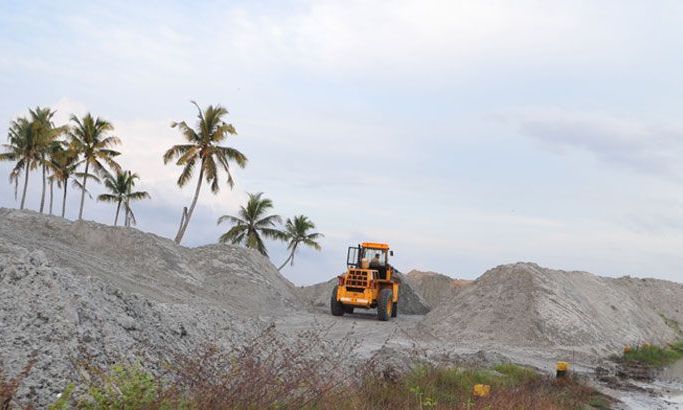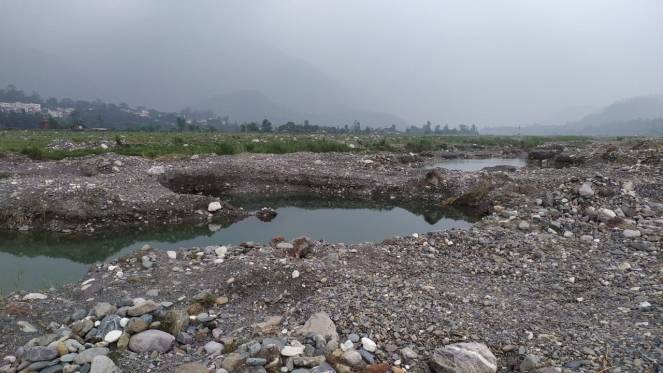Shifting Sands: Illegal sand mining is killing both people and the environment
Illegal sand mining that has come up around uncontrolled construction is taking a toll on environment and human lives. The present regulations and mining guidelines seem inadequate to stem the rot.


Photo: SANDRP
Last year, on July 7, Shanty and Sunil, 14 and 15 years old respectively, died when they drowned in a 30-foot pit left behind by illegal sand mining on the riverbed of the Somb river, a tributary of the Yamuna. This happened in Kanalsi village in Yamuna Nagar district of Haryana. On the very same day, but in Jalpaiguri, West Bengal, over 1,600 km away, a ten-year-old lost his life when he drowned in a similar pit. In 2018, there were 28 deaths reported directly or indirectly connected to illegal river-bed sand mining.
One of them was a deputy ranger who tried to stop illegal sand mining and was murdered by the mining mafia at Morena in the state of Madhya Pradesh.
The same year, a bridge in Birpur Uttrakhand collapsed as an over laden truck of sand went over it, and several journalists, government officials, and anyone who shone a light on illegal sand mining operations, were killed, beaten up or threatened.
In June this year, a journalist, in Unnao district of Uttar Pradesh, was allegedly killed by the sand mafia as he had written about their illegal activities.

Making way for the mafia
A United Nations Environment Programme report of 2014 has estimated that between 32 and 50 billion tonnes of sand and gravel are extracted globally each year with demand increasing, especially in developing countries. In 2018, the Union ministry of mines stated in its ‘Sand mining framework document’ that the demand for sand in the country was around 700 million tonnes and that it was increasing at the rate of six to seven per cent annually.
Illegal sand mining has grown exponentially in the country ever since the 1990s when the economy opened up and along with it the real estate boom. As the building industry flourished, the demand for sand rose unabated. And earth movers and trucks ran amok over river beds mining for sand, till the courts had to impose a ban on sand mining. But since constructions continued unabated, sand mafias emerged across the country to exploit the demand for sand, and the result was a ransacking of river beds.

On killing a river
The impact of river bed mining in India has been devastating to the environment. Using bulldozers that scoop out sand from riverbeds is akin to disemboweling a living being. It has an immense physical, chemical and biological impact on the river system. It kills life forms and disturbs the stream’s turbidity, in the process influences underwater sunlight penetration, interrupts photosynthesis and throws out of sync the dissolved oxygen content, among other things. Its worst impact is on the variety of aquatic life forms stream beds support. Heavy machinery compact the soil and damage and destroy the flora and fauna that exists on those sandy floodplains.
The magnitude of illegal sand mining has come into the public consciousness a decade or so ago. Before that, it was not uncommon to see people carrying away sand on their bullock carts or on a mule for use locally in their villages or in a nearby town. The sand was usually manually scooped out and carried away. Not any more.
In 2009, it took over two hours to cover 23 km between Ghatampur and Hamirpur in Uttar Pradesh on the National Highway-86. Reason was the awful condition of the road thanks to the unending stream of overladen sand trucks, many without number plates, rumbling over what once surely was a black-topped road, but was now no more than a slushy path. The trucks bumped and jolted over the water-filled potholes, trailing a stream of wet sand. Obviously, the vehicles were transporting freshly scooped sand from a river bed, perhaps the Betwa River. Hamirpur, a district headquarters in Uttar Pradesh, about 150 km from the state capital of Lucknow lies the confluence of Betwa with Yamuna. The coarse Betwa ret (sand) is much in demand in and around Kanpur that is 65 km away.

The significance of the environment impact assessment
While mining for minerals is a state subject under the Constitution, its policies and laws are set down by the central government. These are responsible to ensure that mining is not only legal and sustainable but that all revenues due from it accrue duly to the state exchequer. Mines and Mineral (Development and Regulation) Act, 1957 of the government of India regulates the mining activities in the country. Since sand, bajari (gravel) and boulders are designated as ‘minor’ minerals under the act, it is presumed that their mining too is a minor matter.
It was only in 2006 that sand, boulders and gravel (bajri) designated as ‘minor’ minerals were brought by the union ministry of environment & forests, under the purview of the Environmental Impact Assessment (EIA). The EIA is a global environment assessment tool that provides decision makers and concerned public with essential information to plan environmentally sustainable economic development.
In September 2015, the union environment ministry of environment, forest & climate change, introduced a draft notification of the sustainable sand mining policy and the following year published the “Sustainable sand mining management guidelines,” after interventions and directions received from the courts including the National Green Tribunal. In January this year, the sand mining guidelines were updated.
Strangely in April 2020, the environment ministry announced the draft Environment Impact Assessment (EIA) Notification 2020 that seeks to modify the EIA notification of 2006 with major dilutions proposed in regulation of mining activities.

The way forward
Undeniably sand is an important construction material and until and unless a viable alternative is found its use cannot be wished away. The states cannot just look at riverbed mining from the perspective of garnering revenue. They have to understand and acknowledge the grave damage sand mining has on its society, ecology and its economy.
Efforts till date made by the union ministries of mines as well as environment do not instill confidence that mafia led illegal, indiscriminate and unscientific manner of river bed mining can be controlled simply through announcement of guidelines and frameworks. A quote from the 2020 guidelines is illustrative of the ground realities:
“…..in the recent past, it has been observed that there were a large number of illegal mining cases in the country and in some cases, many of the officers lost their lives while executing their duties for curbing illegal mining incidence. The illegal and uncontrolled mining leads to loss of revenue to the State and degradation of the environment….”
The ‘ministry of mines framework document’ seems to be promoting M-sand, short for manufactured sand, as an alternative to river sand. M-Sand is nothing but reversing the natural processes through which rocks like sandstone, quartz and granite were formed. These rocks available either on surface or from the quarries are crushed to the desired size. But it seems to be of little concern that quarrying is mining too and that it devastates hills and its vegetation, robbing biodiversity of its habitats. Many of these hills are critical catchments of small and big streams. It is inexplicable that the said framework while pushing for M-sand does not even make a mention of the sand that could be gainfully dredged from silted reservoirs behind dams to replace river bed mining.
Nationalising sand mining alone can eliminate the role of the mafia and the indiscriminate and unscientific mining practices. The government of India should institute a Sand Corporation of India on the lines of the Food Corporation of India. There should be sand mandies where marketing of sand should be done in a regulated way at predetermined rates.
The matter of sand mining should be tackled at several levels. A district level official should conduct regular survey of reservoirs and rivers in the vicinity; the gram sabha of frontline villages should alone be permitted to collect sand manually from pre-designated sites on the streams and transport it on mules or carts to pucca roadsides from where trucks may take them onwards to the mandies; no trucks or tractors should be permitted within the floodplains of streams and rivers, except perhaps from the draw down areas of large reservoirs or at designated sites in rivers with very vast floodplains.
Clean and green
The world over, ethical consumer campaigns are calling for rejection of products that might have been produced either illegally or through use of child labour, etc.
There must be a similar consumer education campaign where a potential buyer of a residential or commercial property should seek an upfront undertaking from the builder that the sand and boulder used in the construction is from a certified legal and sustainable source only. Any default should result in black listing and attraction of disrepute to the builder from consumer forums.
Sustainability for a replenishable resource like forests, ground water and sand/gravel is crucial. And the secret is to assess and harvest only the annual accrual and no more. It is the obligation and duty of the current generation to see that it does not diminish any natural resource to an extent that little or nothing is left for the use of succeeding generations.

